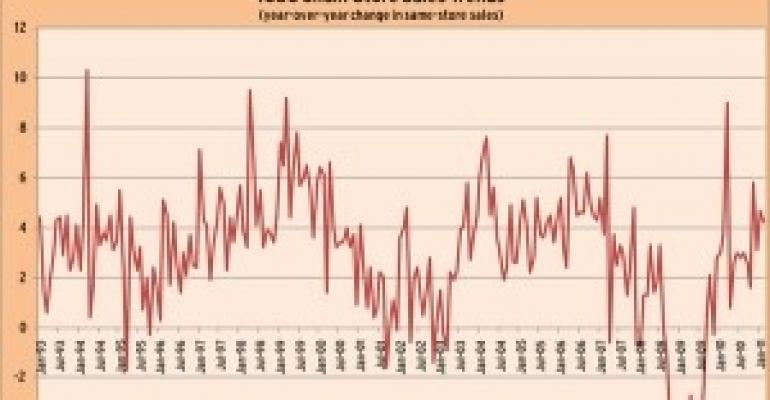In spite of winter storms that hit much of the country and rising fuel prices, same-store sales grew by more than 4 percent in February, according to several tallies of the monthly results. That solid number followed surprisingly strong results in January.
However, the pool of retailers reporting figures this month is the smallest yet thanks to Abercrombie & Fitch Co., Aeropostale Inc. and American Eagle Outfitters Inc. all deciding to stop reporting monthly same-store sales figures last month.
The biggest retailer in the country, Walmart, also no longer reports monthly. It recently reported that its fourth quarter same-store sales were down 1.1 percent, excluding fuel. That, in and of itself, casts a shadow on the veracity of the same-store sales figures. Walmart's size means that when it was part of the pool of retailers reporting, it had the power to shift the overall result up or down by several percentage points. If its declines were still part of the monthly mix, the same-store figures would likely be worse than the headline numbers we're getting now.
As a result, we have to continue to remember to take the same-store numbers with a large grain of salt.
My look inside the monthly reports is after the jump.
Kantar Retail and Retail Sails recorded a 4.4 percent gain, while ICSC estimated that sales rose 4.2 percent.
ICSC's tally shows that same-store sales rose 4.2 percent in February.
ICSC's numbers are based on 28 retailers.
In its monthly commentary, ICSC wrote:
The breadth and strength of the sales gain in February was encouraging as more retailers and retail segments participated in the improvement. The industry was “firing on all cylinders” in February and largely brushed off the adverse impacts of weather during the month.Department stores posted a 5.7% gain in February--outperforming the industry. Macy's CEO
attributed some of its strong performance to healthy “consumer reaction to new spring merchandise” offerings. Even within store offerings, the sales strength was widespread as Kohl's noted. Kohl's CEO comment on his company's performance that “all lines of business” were positive for the month.
...
The widespread improvement in February is on the heels of improving labor markets, broader improving economic conditions and the reduction in the payroll tax--which collectively are more than offsetting the potentially negative drag from high fuel and rising food prices on the consumers' market basket. To be sure, ICSC Research further observed in its own statistical
analysis that there is a fair amount of pent-up demand still unmet from the past two years that is helping to drive consumer spending as well.
February is a low volume month for sales, which makes it more susceptible to unexpected swings, which may be contributing to the very strong trend since the beginning of 2011 (that is, a little better performance is amplified). Moreover, the shift in the upcoming date of Easter this year versus last will introduce “noise” over the upcoming two months.
Here are ICSC's monthly same-store sales year-over-year changes, not seasonally adjusted, going back to 1993.
Click to enlarge.
Here is ICSC's index of same-store sales, seasonally adjusted, going back to 1992.
Click to enlarge.
According to Kantar Retail, sales-weighted same-store sales increased 4.4 percent in February for the 28 retailers that reported numbers (most of which were apparel retailers). (A pdf with each retailer's results can be downloaded here.) The results were led by stronger-than-average results at department stores. Food, drug and mass retailers followed. Lagging were apparel and accessory Stores.
Frank Badillo, senior economist at Retail Forward, said in a statement, ““The results also held up despite slightly tougher year-ago comparisons, but those comparisons are likely to take a toll in the coming months—even factoring out the Easter shift from March to late April this year. Higher fuel prices will have an ongoing impact on shoppers, particularly lower-income shoppers, but that impact will be offset somewhat as long as households see a continuing pickup in income and job gains in the months ahead.”
Here are two figures from Kantar's Retail ShopperScape Survey.
Click to enlarge.
RetailSails also measured a 4.4 percent, looking at 27 retailers.
Retailers started off the new fiscal year on a strong note, as February same-store sales came in better than expected and all indications point to a strong start to the spring selling season. A combination of pent-up demand after severe weather across much of the country limited shopping in January, and event-driven spending on the Super Bowl, Valentines Day and President's Day helped chains continue the momentum from a robust Holiday season.Total sales for the 27 companies we track increased 6.6% to $30.3 billion, while same-store sales rose 4.4% following a 5.1% rise in January and on top of a 3.9% gain last February – this was the 18th straight gain after 12 consecutive months of declines, and better than the 3.6% comp rise analysts were expecting. 22 out of 27 retailers reported comp increases for the month, compared to 21 last year and just 8 in February 2009.
...
Rising prices are not just a worry for consumers, though. Retailers are dealing with oil over $100 barrel again, cotton prices at 150-year highs and labor costs skyrocketing in traditionally cheap countries for manufacturing. Though this doesn't seem to have affected 4th quarter margins much, every company is starting to talk about the impact it will have in the year ahead.





